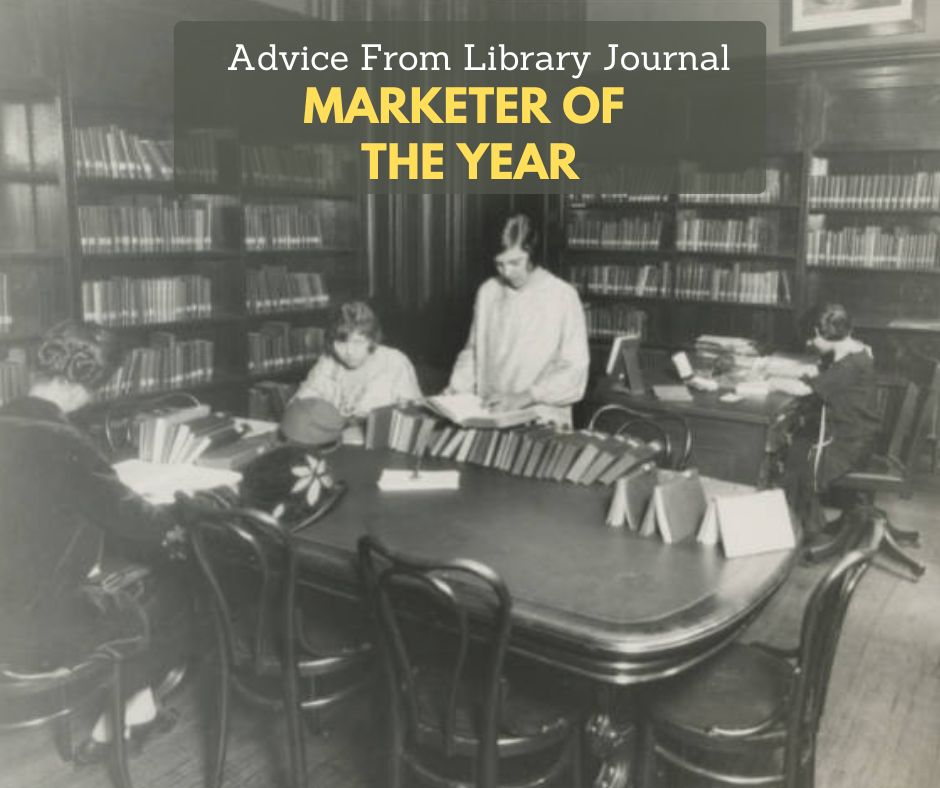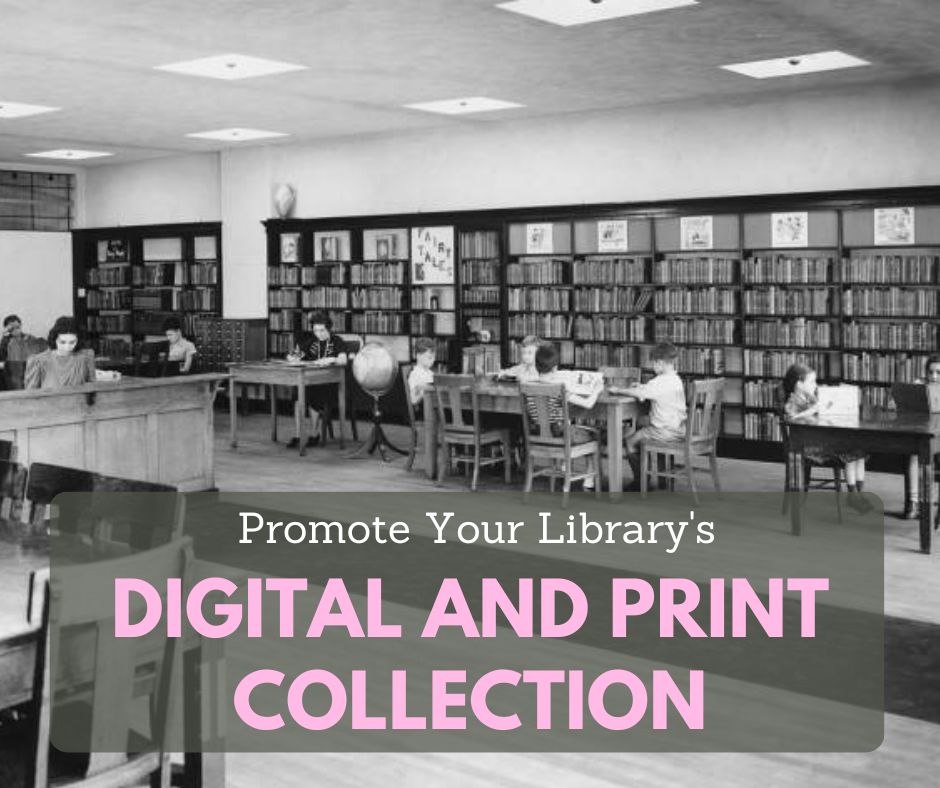
A few months ago while at a conference, Meghan McCorkell, got the email of a lifetime. The chief of Marketing, Communications, and Strategy for the Enoch Pratt Free Library, she called back to Baltimore and put her team on speaker phone.
Meghan was delivering great news: her team won the coveted Library Marketer of the Year award from Library Journal.
“We all jumped around excited (them in the office and me in a hotel lobby),” recalled Meghan. “More than anything I am so proud that we won as a team. We had to keep it a secret for about two months. So that was challenging.”
Meghan’s road to award-winning library marketer began in the 7th grade when she volunteered to shelve books for her hometown library, the Brielle Public Library on the Jersey Shore. Little did she know that years later, after a successful career as an Emmy-award-winning television journalist, she would assemble a team and lead the marketing for the vibrant Enoch Pratt Free Library.
“I love being surrounded by creative people, who all think differently than me,” explained Meghan. “I’m constantly blown away by the ideas that bubble up from our team. Six years ago, the Pratt didn’t have a marketing department. With support from the CEO, we built it.”
“The Print & Design studio was originally part of the Programming department, with four talented designers, Katherine Marmion, Eric Archibald, Jamillah Abdul-Saboor, and Jack Young. The studio was reorganized into a new marketing department.”
“We hired Andrew Klein to oversee the robust work that department does, as well as to lead the revamp of our Compass magazine. Our social media manager, Vianey Becerra, was made full-time, and translation duties were added because Vianey is bilingual.”
“A few years in, as we built out our email marketing strategy we brought on Ashley Barnes, a digital marketing strategist. And finally, I advocated for a photographer/videographer position. John Cassini was a former news photographer, so given our skill sets together the Pratt now has its own full-service production studio.”
Like many libraries, Enoch Pratt really had a challenging time communicating with patrons during the Covid lockdown because of the digital divide. Nearly 40 percent of Baltimore residents had no access to a computer or Wi-Fi at the time lockdown began.
“When we knew we’d have to close library doors, we started working nonstop to figure out how we’d serve the customers who rely on us,” remembered Meghan. “We started trying new things to see what worked.”
“We used census data to send targeted postcards with QR codes and unique URLs in communities where internet in households was unreliable. We let them know about device lending and our free outdoor Wi-Fi. We geofenced those communities and pushed targeted ads that looked like those postcards.”
“We sent targeted emails based on location and library usage trends to customers. We were specific in how we reached people, who we were trying to reach, and measuring what was successful.”
“That all may sound pretty complicated and expensive, but targeting that way actually really cuts down on the cost. If you can mine the data and figure out who needs to hear your message, you can send 5,000 postcards instead of 50,000.”
Once the doors of Enoch Pratt reopened, the team faced a huge challenge: rebuilding cardholder usage.
“It was a daunting task,” admitted Meghan. “We define active cardholders as customers that used the library in the past year. During COVID we lost more than half of those cardholders. But we learned a lot of lessons along the way too, and we doubled down on what worked.”
“Pre-pandemic we sent around 5-6 emails a month. That expanded massively as we launched more regular campaigns and saw success.”
“Today, we send anywhere between 35-40 targeted emails a month to different audiences, have an unsubscribe rate of less than 1 percent, and regular open rates close to the 50 percent mark.”
“Our print publication, the Compass used to be a 16-page list of programs. Over the past 4 years, we’ve expanded to a 24-page magazine that tells the library’s story. Staff across the library also stepped up with dynamic programs and services responding to community needs. Last week, we hit 3,000 more active cardholders than our pre-pandemic high. So, we’ve climbed the mountain.”
Reflecting on the work, and her team, Meghan clearly gives credit for their LJ win to her team, whom she says make it a joy to come to work. They even came up with a creative approach to their award photo shoot.
“Library Journal let us take our own picture for the feature, and of course, we couldn’t give them something normal,” exclaimed Meghan. “The Brady Bunch style photo perfectly captures the spirit of everyone on the team. We shared a behind-the-scenes video on the Pratt’s Instagram page of our photo shoot.”
Though Meghan has a wealth of riches in her large and talented team, she still faces struggles in terms of budget. Many of the tactics her team uses to reach cardholders can be replicated by smaller libraries.
“My advice would be to look at low to no-cost tactics,” explained Meghan. “I think targeted emails can really change the game.”
“Start a sign-up list at your library for people interested in kids’ events. Create a really specific monthly email for that audience and keep an eye on how it performs and if it’s achieving your goals of getting more people through the doors. That’s how we started our email strategy. Then we were able to leverage the success of those lists to convince our Board that we could be more successful with fancy software.”
“I also think you should try things, and if they don’t work, let them go. Just because things have always been done a certain way doesn’t mean you should keep doing it. Try new things. Fail. Try more things.”
Meghan’s team is now focusing on cardholder retention and data collection.
“I don’t like throwing spaghetti at a wall and seeing if it sticks,” said Meghan. “I want to run measurable marketing campaigns the whole way through.”
“We’ve got some fun upcoming projects like our Macy’s-style winter windows that have become a Baltimore tradition thanks to our amazing graphic design team. We’ve got some challenges too including messaging out a Master Facilities plan and a series of upcoming renovation projects. Our designer Eric is probably already stressing the design of next year’s Summer Break Baltimore shirt! His design this year has been directly cited by customers for a 36 percent increase in program participation. (no pressure, Eric!)”
When she needs inspiration, Meghan looks at the work of other library marketers.
“I’ve made amazing friends in library marketing. I send them emails and say ‘What do you think about this’ all the time. The environment is so collaborative.”
“For inspiration, I’m often looking at other industries and seeing how we could adapt ideas from there. Right now, I’m in love with our Library Card Sign-up Month video campaign. That was born out of a brainstorming session with our whole team. Our graphic designer Katherine said, ‘What about those annoying lawyer commercials?’ That idea led to a 3-video campaign that is becoming wildly popular on social media. We even have it running on a TV station and in a movie theater now.” (Here are the videos: Lawyer Commercial, Car Commercial, Pharma Commercial.)
Meghan wants my readers to know that, although she’s had a lot of success in her current role, there was a time not too long ago when she was uncertain. For support, she turned to you… the community of library marketing professionals!
“Six years ago, I felt like I was just figuring out what the heck I was doing in a new career,” remembered Meghan. “One of the things that helped was finding the community of people in this field.”
“Library marketers are really collaborative and we’re all facing the same challenges. I love hearing from colleagues who want more info on going fine-free, or major renovations. I reach out to friends in the field to talk about ideas. From this blog to social media groups, and conferences, there is a sea of people out there all rooting for each other to succeed. Go find them!”
P.S. Want more advice?
Subscribe to this blog and you’ll receive an email whenever I post. To do that, enter your email address and click on the “Follow” button in the lower left-hand corner of the page. You can also follow me on the following social media platforms:



